Introduction to Canine Massage and Physical Therapy

Canine massage and physical therapy are specialized forms of therapy designed to improve the health and well-being of dogs. Massage therapy involves the manipulation of muscles and soft tissues to promote relaxation, relieve pain, and improve circulation. Physical therapy, on the other hand, focuses on specific exercises and techniques to improve a dog's range of motion, strength, and overall mobility.
These therapies offer numerous benefits for dogs, including pain management, improved range of motion and flexibility, enhanced circulation and healing, stress relief and relaxation, increased muscle tone and strength, rehabilitation and injury recovery, and promoting overall well-being. By incorporating these therapies into a dog's daily routine, their quality of life can be greatly improved.
Certified canine massage therapists and physical therapists can provide professional assistance in implementing these therapies for dogs. Their expertise ensures that each session is tailored to the individual needs of the dog, maximizing the benefits gained from these treatments.
Definition and importance
Canine massage and physical therapy involve the hands-on manipulation of a dog's muscles and tissues to improve their well-being. It is an essential part of holistic veterinary care that focuses on promoting wellness and preventing health issues in dogs.
The importance of canine massage and physical therapy lies in its ability to alleviate pain, promote healing, increase range of motion, enhance circulation, reduce stress, develop muscle strength and tone, aid in rehabilitation, and overall improve the quality of life for dogs. By addressing these aspects, massage and physical therapy help support dogs' physical health and emotional well-being. This therapeutic approach is especially beneficial for dogs recovering from injuries or surgeries or those suffering from chronic conditions such as arthritis or mobility issues.
Benefits of canine massage and physical therapy

Canine massage and physical therapy offer numerous benefits for dogs. Firstly, it helps in pain management for various conditions such as arthritis, hip dysplasia, and muscle strains. By targeting the affected areas and using techniques like gentle manipulation, stretching, and pressure points, massage and physical therapy help alleviate discomfort and improve dogs' overall quality of life.
Additionally, these therapies improve a dog's range of motion and flexibility by loosening tight muscles and increasing joint mobility. They also enhance circulation by stimulating blood flow to tissues and organs, promoting faster healing and reducing inflammation.
Furthermore, canine massage therapy aids in stress relief and relaxation by releasing endorphins and reducing anxiety levels in dogs. It also contributes to strengthening muscles, which helps prevent future injuries.
Overall, incorporating canine massage therapy and physical therapy into a dog's routine can greatly improve their well-being, mobility, and overall quality of life.
Pain Management for Dogs
Common conditions that can be treated with massage and physical therapy include arthritis, hip dysplasia, muscle strains, and post-surgical pain. Canine massage and physical therapy are effective in managing pain in dogs by reducing inflammation, increasing blood flow to the affected area, and releasing endorphins to provide natural pain relief. Massage techniques such as effleurage, kneading, and trigger point therapy can target specific areas of discomfort, promoting relaxation and alleviating pain. Physical therapy exercises like stretching, range of motion movements, and hydrotherapy can also help relieve pain by strengthening muscles around the affected joints or injured areas. Canine massage and physical therapy play a significant role in ensuring the comfort and well-being of dogs experiencing pain.
Common conditions that can be treated with massage and physical therapy

Some common conditions that can be effectively treated with massage and physical therapy in dogs include arthritis, hip dysplasia, muscle strains and sprains, post-surgical recovery, and neurological disorders. Arthritis is a degenerative joint disease that causes inflammation and pain in the joints, and massage therapy can help alleviate the discomfort by improving blood flow and stimulating the release of natural pain-relieving hormones. Hip dysplasia, a condition characterized by abnormal hip joint development, can also benefit from physical therapy exercises that strengthen the surrounding muscles and improve joint stability. Muscle strains and sprains can be treated with targeted massage techniques to reduce inflammation and promote healing. Additionally, dogs recovering from surgeries or dealing with neurological disorders such as paralysis can benefit from massage and physical therapy to regain mobility and strength in affected areas.
How massage and physical therapy help manage pain in dogs
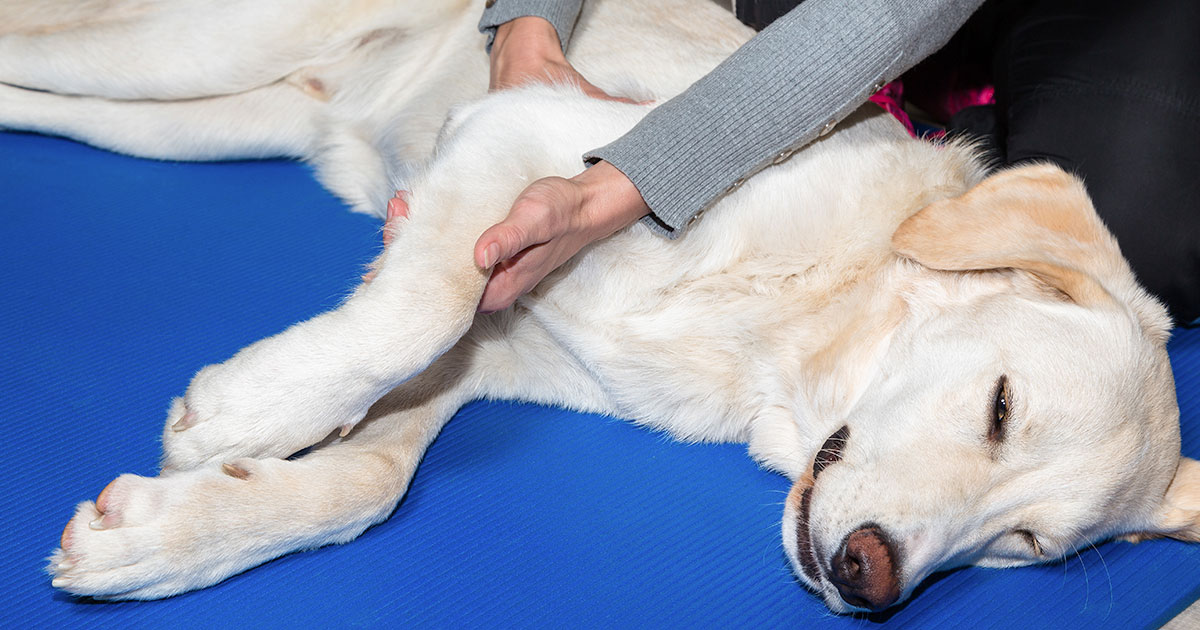
Massage and physical therapy can be effective in managing pain in dogs. Massage helps to increase blood flow and reduce muscle tension, which can alleviate pain caused by conditions such as arthritis or muscle strains. It also stimulates the release of endorphins, the body's natural pain-killers, providing further relief. Physical therapy techniques, such as joint mobilizations and stretching exercises, can help improve joint mobility and reduce pain associated with conditions like hip dysplasia or spinal issues. Additionally, these therapies can help dogs regain strength and flexibility after surgery or injury, reducing the risk of future pain or discomfort. By addressing the underlying causes of pain and promoting healing, massage and physical therapy can enhance a dog's overall well-being and quality of life.
Improved Range of Motion and Flexibility
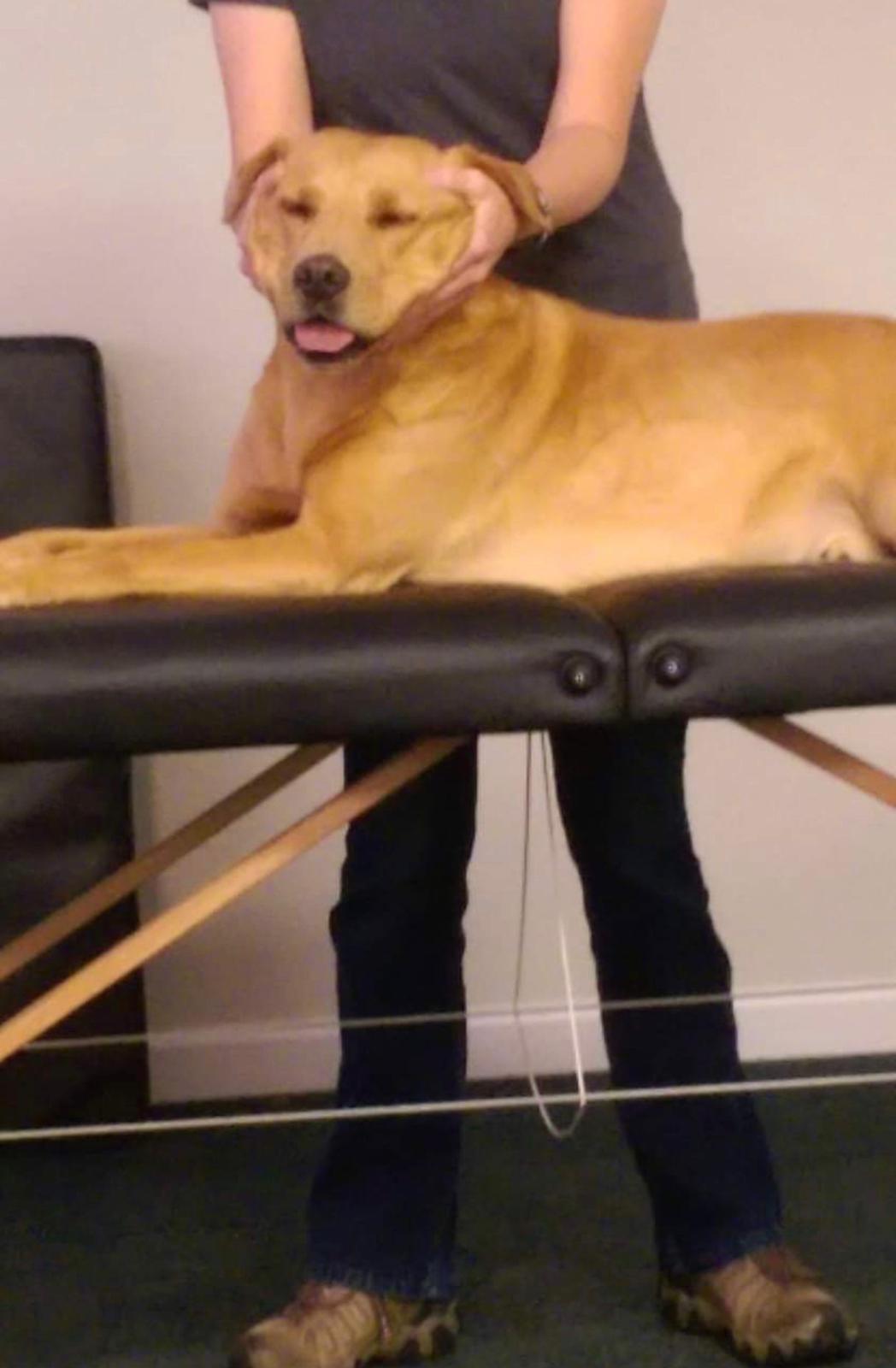
How massage and physical therapy improve a dog's range of motion
Massage and physical therapy play a crucial role in improving a dog's range of motion and flexibility. These therapies help by promoting joint mobility and reducing muscle tension, which can limit a dog's movement. Through gentle manipulation and stretching techniques, massage therapists and physical therapists work to increase the range of motion in a dog's joints.
By targeting specific areas of tightness or stiffness, massage helps to release tension and improve flexibility. Physical therapy exercises such as stretching, range-of-motion exercises, and balance training also contribute to enhancing a dog's overall flexibility.
The combination of massage and physical therapy not only increases a dog's range of motion but also helps to prevent further joint stiffness or muscle tightness, ensuring optimal mobility for the dog.
How massage and physical therapy improve a dog's range of motion

Massage and physical therapy play a crucial role in improving a dog's range of motion. Through targeted techniques and exercises, these therapies can help increase the flexibility and mobility of the dog's joints and muscles.
Massage therapy helps by loosening tight muscles, reducing muscle tension, and breaking down scar tissue that may be limiting the dog's movement. It also promotes better blood flow to the muscles, allowing for improved flexibility.
Physical therapy techniques such as stretching exercises help to lengthen the muscles and increase their elasticity. This aids in improving the dog's overall flexibility and range of motion.
By regularly incorporating massage and physical therapy into a dog's routine, pet owners can effectively enhance their furry friend's range of motion, allowing them to move more comfortably with greater ease.
Exercises and techniques for enhancing flexibility
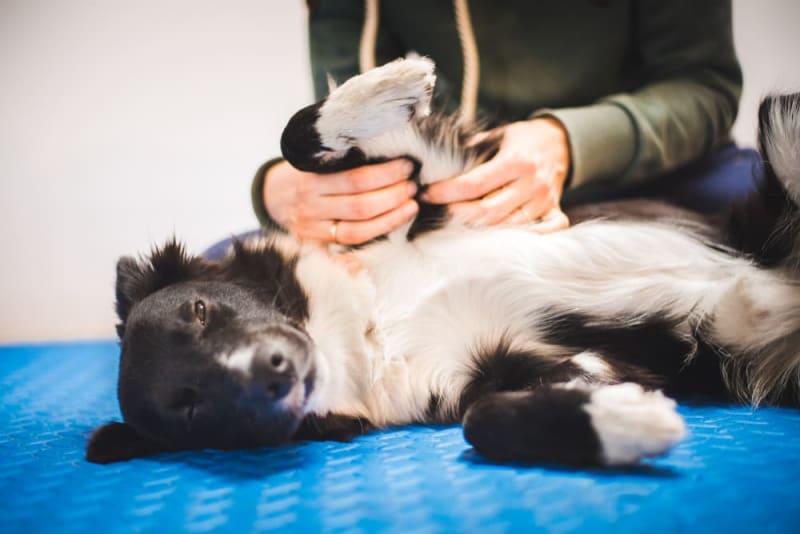
To enhance the flexibility of dogs, there are several exercises and techniques that can be employed. One effective exercise is stretching, which helps to improve muscle flexibility and joint mobility. Gentle stretches should be performed for each major muscle group, focusing on areas such as the neck, shoulders, hips, and legs.
Another technique that can aid in enhancing flexibility is range of motion exercises. These involve gently moving the joints through their full range of motion, promoting increased flexibility and preventing stiffness.
Additionally, hydrotherapy can be beneficial for improving a dog's flexibility. Swimming or water-based exercises provide low-impact resistance while supporting the joints, allowing for increased range of motion without causing further strain.
By incorporating these exercises and techniques into a dog's routine under the guidance of a professional, their flexibility can be improved, leading to better overall physical health and mobility.
Enhanced Circulation and Healing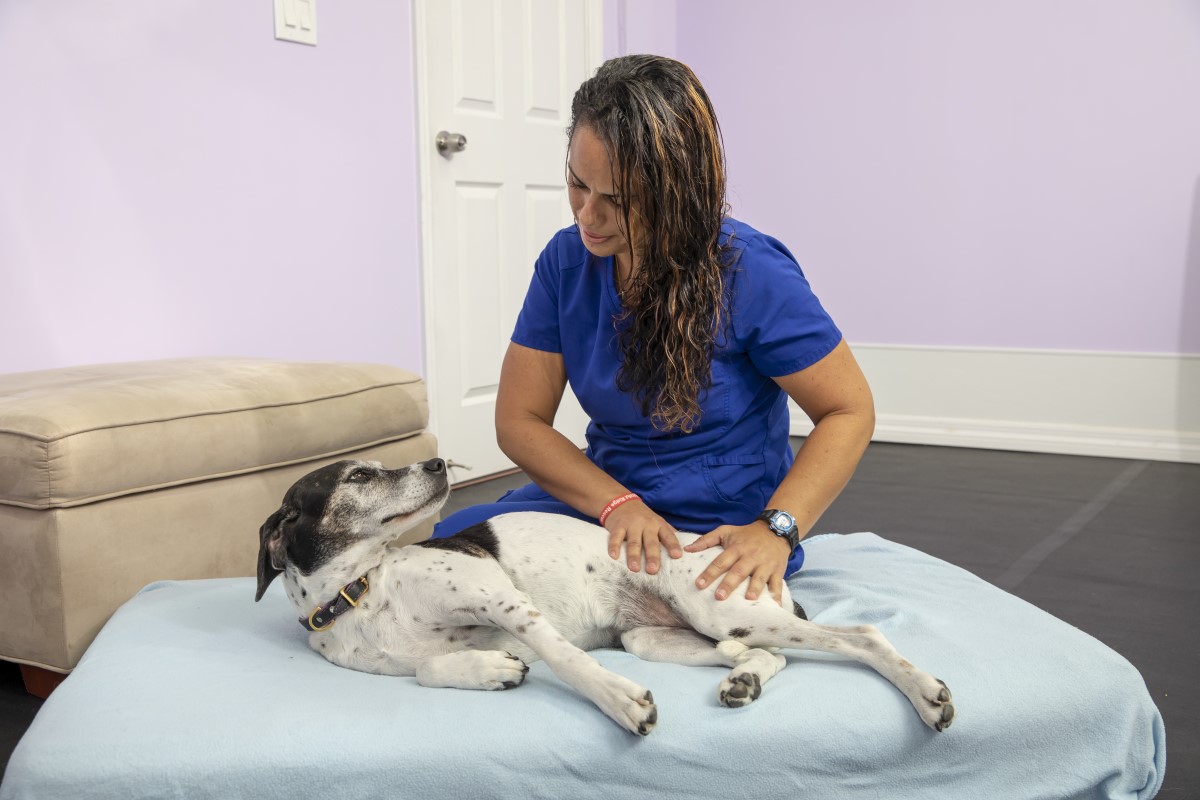
How massage and physical therapy improve blood circulation in dogs:
Massage and physical therapy techniques have been shown to improve blood circulation in dogs. The manipulation of tissues through massage helps increase blood flow to the muscles, joints, and other areas of the body. This improved circulation allows for better oxygen and nutrient delivery to the tissues, promoting healing and overall health.
The healing benefits of improved circulation in canines:
Enhanced circulation plays a crucial role in the healing process for dogs. It helps remove waste products and toxins from tissues, reducing inflammation and swelling. Additionally, increased blood flow aids in tissue repair by bringing essential nutrients to damaged areas. This can accelerate the healing process and improve recovery from injuries or surgical procedures.
By improving blood circulation, canine massage and physical therapy offer significant benefits for the overall well-being of dogs.
How massage and physical therapy improve blood circulation in dogs

Massage and physical therapy can improve blood circulation in dogs by promoting vasodilation, which is the widening of blood vessels. During the massage or therapy session, the therapist uses various techniques like stroking, kneading, and compression to stimulate the blood flow. These movements help relax the muscles and tissues, allowing for better circulation.
By improving blood flow, massage and physical therapy assist in delivering oxygen and nutrients to all parts of a dog's body more efficiently. This increased circulation also aids in removing waste products and toxins from tissues, helping them heal faster. Additionally, better blood flow can reduce inflammation and swelling in injured areas.
Regular massage and physical therapy sessions can significantly enhance a dog's overall health by optimizing their circulatory system and supporting their well-being.
The healing benefits of improved circulation in canines

Improved blood circulation in canines has several healing benefits for their overall health and well-being. When circulation is enhanced, it allows for better oxygen and nutrient delivery to the body's tissues, helping to promote healing and repair.
Improved circulation can aid in reducing inflammation and swelling, as well as removing waste products from the body more efficiently. This can be particularly beneficial for dogs recovering from injuries or surgeries.
Additionally, enhanced blood flow promotes the release of endorphins, which are natural painkillers. This can help alleviate discomfort and provide a sense of comfort for dogs experiencing pain or discomfort.
By improving circulation through massage and physical therapy, owners can support their canine companions' healing process, allowing them to recover faster and enhance their overall quality of life.
Stress Relief and Relaxation

Massage therapy is not only beneficial for physical well-being but also plays a significant role in providing stress relief and relaxation for dogs. This form of therapy helps dogs to unwind and reduce anxiety and stress levels. Through the gentle touch and soothing techniques, massage stimulates the release of endorphins, which are natural mood enhancers. Additionally, massage therapy promotes relaxation by lowering heart rate and blood pressure, allowing the dog to enter a state of deep calmness.
Not only does massage have physiological effects, but it also has psychological benefits. Dogs that receive regular massages often experience improved emotional well-being and an increased sense of trust and connection with their owners. This contributes to an overall improvement in their quality of life and helps in managing stress-related behavior problems.
Massage therapy is a valuable tool that dog owners can utilize to help their furry friends find relief from stress and achieve a state of relaxation. By incorporating regular massage sessions into their daily routine, owners can promote a healthier mind and body for their canine companions.
How massage therapy helps dogs relax and reduces stress

Massage therapy is not only beneficial for physical health but also plays a significant role in promoting relaxation and reducing stress in dogs. Through gentle and soothing touch, massage stimulates the release of endorphins, which are natural mood-enhancing chemicals that help induce feelings of relaxation and calmness.
The rhythmic strokes and kneading motions used in massage therapy help to ease muscle tension, leading to a state of deep relaxation in dogs. This relaxation response triggers a decrease in heart rate, blood pressure, and stress hormones, such as cortisol. As a result, dog owners often notice their furry companions becoming more at ease and exhibiting less signs of stress or anxiety.
By providing a safe and comforting environment, focused attention, and gentle touch, massage therapy can help dogs relax both physically and mentally. Incorporating regular massage sessions into a dog's routine can have a profound impact on their overall well-being and quality of life.
The physiological and psychological effects of relaxation in canines

Relaxation can have significant physiological and psychological effects on canines. Physiologically, when dogs are in a relaxed state, their heart rate decreases, leading to improved cardiovascular health. Their blood pressure also lowers, reducing stress on the heart and improving overall cardiovascular function. Further, relaxation promotes better digestion and enhances the immune system.
Psychologically, relaxation helps reduce anxiety and decreases the release of stress hormones such as cortisol. This leads to a calmer demeanor in dogs, helping them cope with stressful situations more effectively. Additionally, relaxation promotes better sleep patterns, allowing dogs to enter deep sleep stages crucial for rest and rejuvenation.
Overall, when dogs experience relaxation through massage therapy, they not only achieve physical benefits but also enjoy improved mental well-being and quality of life.
Strength and Muscle Tone Development

Massage and physical therapy play a crucial role in strengthening dogs' muscles and improving their muscle tone. By targeting specific muscle groups through massage techniques and therapeutic exercises, dogs can develop increased strength and endurance.
Massage stimulates the muscles, promoting blood flow and oxygenation, which aids in muscle growth and repair. Physical therapy exercises, such as range of motion exercises and resistance training, help build and tone muscles. These activities challenge the muscles to adapt and become stronger over time.
Regular massage and physical therapy sessions can gradually enhance a dog's muscle tone, leading to improved athletic performance, agility, and overall mobility. It is essential to work with a certified canine massage therapist or physical therapist who can create tailored treatment plans to address specific muscle weaknesses or imbalances.
How massage and physical therapy contribute to strengthening dogs' muscles

Massage and physical therapy play a crucial role in strengthening a dog's muscles. Through targeted techniques and exercises, these therapies help improve muscle tone and overall strength in canines.
Massage therapy involves the application of specific pressure and strokes to stimulate blood flow to the muscles. This increased circulation helps deliver essential nutrients and oxygen, facilitating muscle growth and repair. Additionally, massage can help release muscle tension and knots, promoting flexibility.
Physical therapy for dogs often includes exercises like stretching, resistance training, and balance work. These activities target specific muscle groups, gradually increasing their strength over time. Physical therapists also employ modalities such as electrical stimulation or ultrasound to further enhance muscle function.
By combining regular massage sessions with tailored physical therapy exercises, dogs can experience significant improvements in muscle tone, leading to enhanced mobility, endurance, and overall strength.
Exercises and techniques for building muscle tone in canines

To build muscle tone in canines, there are several exercises and techniques that can be beneficial. One effective method is resistance training, which involves using resistance bands or weights to provide added resistance during exercises. This helps to strengthen the muscles and improve tone. Another technique is balance training, which involves activities that challenge a dog's balance, such as balancing on an unstable surface or walking on a balance beam. These exercises engage the muscles and help to improve overall muscle tone. Additionally, incorporating regular cardiovascular exercises like running or swimming can also contribute to muscle development in dogs. It's important to consult with a professional canine physical therapist to determine the best exercises and techniques for your dog's specific needs and abilities.
Rehabilitation and Injury Recovery
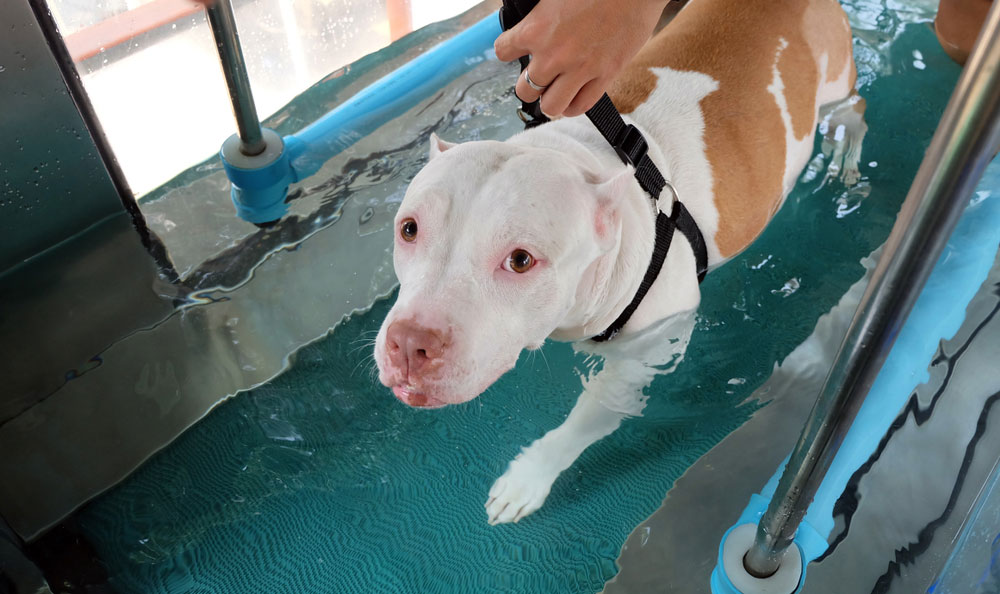
The role of massage and physical therapy in the rehabilitation process for dogs is crucial. These therapeutic techniques can help dogs recover from various injuries, such as sprains, strains, fractures, and surgeries.
Massage therapy aids in reducing muscle tension and promoting blood circulation to the injured area. It also helps alleviate pain and inflammation, while physical therapy exercises assist in restoring muscle strength and flexibility. By combining these approaches, dogs can regain their mobility and functionality faster.
Numerous case studies and success stories highlight the effectiveness of massage and physical therapy in supporting injury recovery in dogs. From agility athletes to aging pets, these techniques have shown significant improvements in mobility and overall well-being.
Rehabilitation should always be supervised by certified professionals who can tailor the treatment plan to address each dog's specific needs.
The role of massage and physical therapy in the rehabilitation process for dogs

Massage and physical therapy play a crucial role in the rehabilitation process for dogs. When a dog has suffered an injury or undergone surgery, these therapies help promote healing and regain functionality. Massage helps reduce pain, decrease inflammation, and increase blood flow to the affected areas, which aids in tissue repair. It also helps relax muscles and reduce swelling, allowing for improved range of motion.
Physical therapy involves targeted exercises and movements tailored to the specific needs of the dog. These activities help rebuild strength, improve balance and coordination, and enhance muscle tone. Rehabilitation programs often include techniques such as hydrotherapy and therapeutic ultrasound to speed up recovery.
By incorporating massage and physical therapy into a comprehensive rehabilitation plan, dogs can regain their mobility and return to their normal activities more quickly. These therapies greatly contribute to the overall well-being of the dog during the recovery process.
Case studies and success stories of dogs recovering from injuries
During the course of massage therapy and physical therapy, there have been numerous case studies and success stories documenting the recovery of dogs from various injuries. These tales of triumph showcase the remarkable benefits of this alternative approach to healing.
One such case involved a dog who had suffered a severe spinal injury. Through a combination of targeted massages and specialized exercises, the dog regained mobility and strength in its hind legs, defying all expectations. Another heartening success story featured a canine athlete who had torn its ACL. With dedicated rehabilitation sessions focused on strengthening the injured leg, the dog not only returned to its athletic pursuits but achieved even greater heights.
These inspiring accounts emphasize the effectiveness of massage and physical therapy in enhancing a dog's rehabilitation process and restoring their quality of life.
Promoting Overall Well-being and Quality of Life
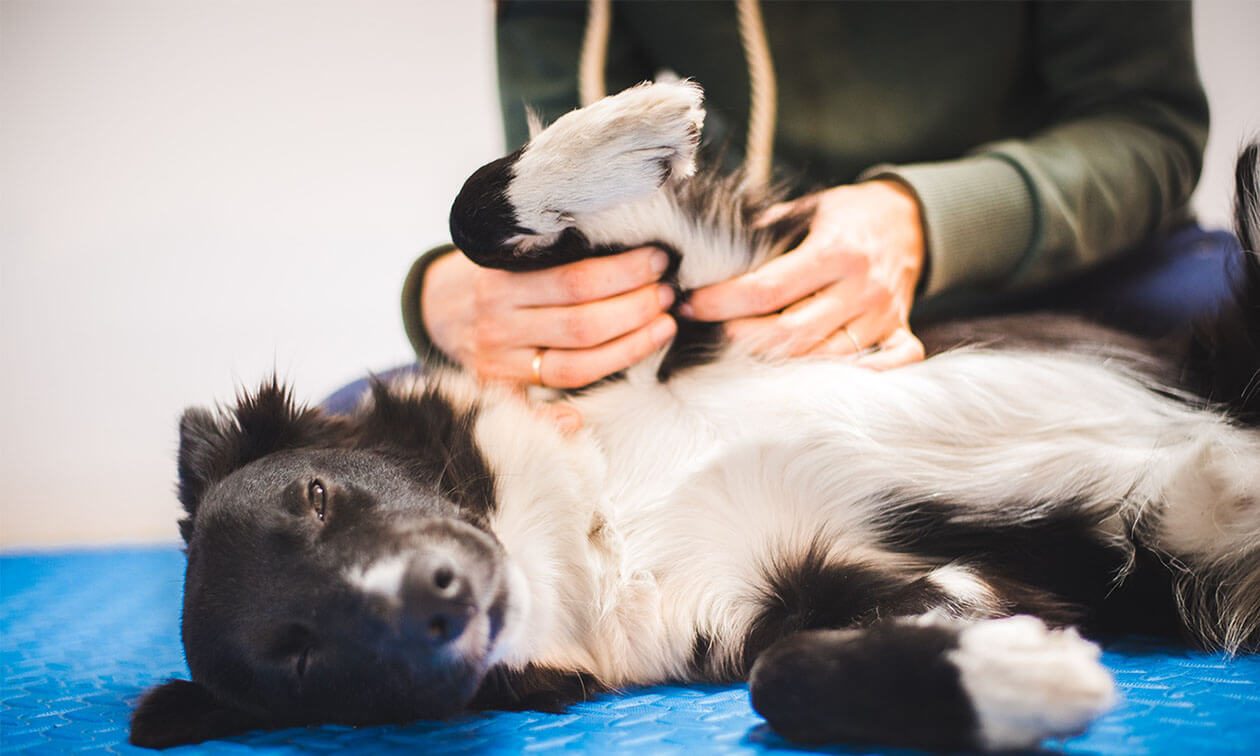
Massage therapy and physical therapy not only provide immediate relief from pain and discomfort but also contribute to the overall well-being and quality of life of dogs. Regular massage sessions can help improve a dog's mood and emotional state by reducing stress and anxiety. The gentle touch and soothing techniques used in massage therapy promote relaxation, which has both physiological and psychological benefits for dogs.
Furthermore, incorporating massage therapy into a dog's daily routine helps strengthen the bond between the dog and their caregiver, which enhances their overall happiness and satisfaction. By dedicating time to provide massage therapy, caregivers can show their love and care for their canine companions while also improving their well-being.
To fully reap the benefits of canine massage therapy, caregivers can seek professional advice from certified canine massage therapists who can provide customized treatments tailored to the specific needs of each dog. By prioritizing their dog's well-being, caregivers can ensure that their furry friends lead happy, healthy lives.
How massage and physical therapy contribute to a dog's overall well-being
Massage and physical therapy play a crucial role in promoting a dog's overall well-being. These therapeutic techniques provide various benefits that contribute to the physical, mental, and emotional health of dogs. By targeting specific areas of the body, massage helps release tension, improves circulation, and reduces muscle soreness. It also helps to alleviate stress and anxiety, leading to a more relaxed state of mind. Physical therapy exercises designed for dogs help improve balance, coordination, and stamina while strengthening muscles and joints. Regular sessions of massage and physical therapy not only enhance a dog's quality of life but also support their overall health and happiness. Incorporating these practices into a dog's daily routine can have profound positive effects for their well-being.
Keywords: overall well-being, therapeutic techniques, physical health, mental health, emotional health, release tension, improve circulation, reduce muscle soreness, alleviates stress and anxiety, balance
Ways to incorporate massage therapy into a dog's daily routine
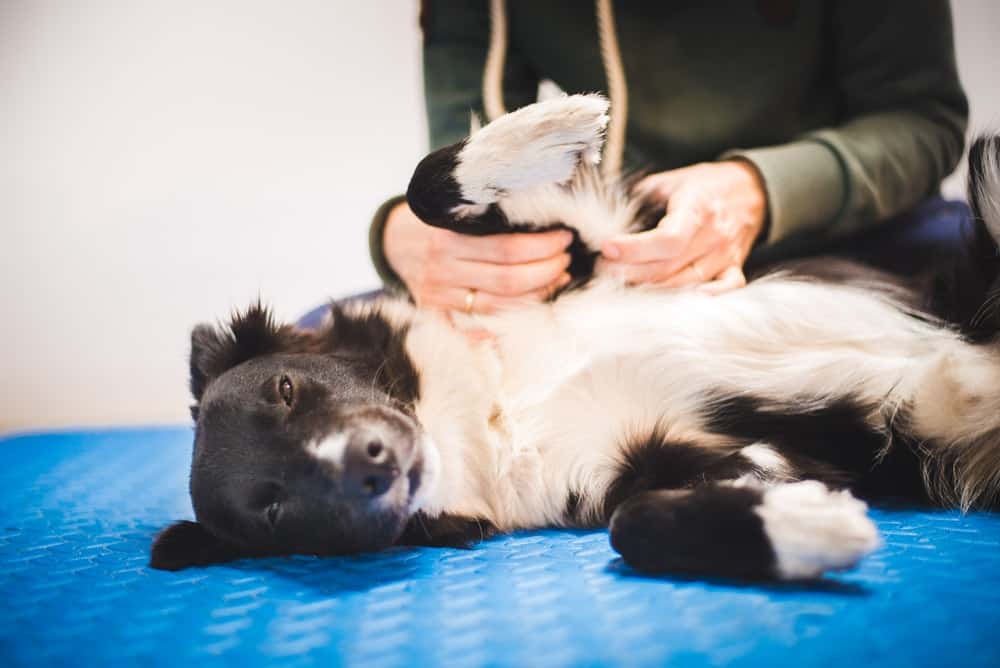
Ways to incorporate massage therapy into a dog's daily routine:
- Start by establishing a dedicated space for massage sessions. Choose a quiet and comfortable area where your dog can relax and feel safe.
- Begin with gentle touches and strokes to help your dog become accustomed to the sensation of massage. Gradually increase the pressure and duration of each session over time.
- Use a variety of massage techniques, such as effleurage (long, sweeping strokes), kneading, and circular motions, to target different areas of your dog's body.
- Incorporate massage into everyday activities, such as during grooming sessions or after exercise, to provide regular relief and relaxation for your dog.
- Pay attention to your dog's body language and adjust the pressure and intensity of the massage accordingly. Respect any signs of discomfort or resistance.
- Make massage a bonding experience by speaking softly to your dog and maintaining a calm and soothing energy throughout the session.
By incorporating these simple steps into your dog's daily routine, you can promote their overall well-being and enhance the benefits of massage therapy for their physical health and emotional relaxation.
Conclusion

In conclusion, canine massage and physical therapy offer a wide range of benefits for dogs in terms of pain management, improved range of motion, enhanced circulation and healing, stress relief, strength and muscle tone development, rehabilitation and injury recovery, and overall well-being. By incorporating massage and physical therapy into a dog's daily routine, pet owners can help their furry companions lead healthier and happier lives.
These therapies not only address specific ailments and conditions but also contribute to the overall quality of life for dogs. It is important to consult with certified canine massage therapists and physical therapists who have the expertise in providing these treatments. Their knowledge and skills ensure that the massages and exercises are done safely and effectively.
To find professional resources for certified therapists, pet owners can consult local veterinary clinics or organizations dedicated to animal health and wellness. With regular sessions of canine massage and physical therapy, dogs can experience the numerous benefits that these treatments provide.
The benefits of canine massage and physical therapy summarized

Canine massage and physical therapy offer numerous benefits for dogs, improving their overall well-being and quality of life. By providing pain management, these therapies can alleviate discomfort caused by conditions such as arthritis or hip dysplasia. Additionally, they enhance a dog's range of motion and flexibility, allowing them to move more freely and comfortably. The improved blood circulation that comes with massage and physical therapy aids in healing, reducing inflammation and promoting tissue repair. Dogs also experience stress relief and relaxation during these sessions, which have positive psychological and physiological effects. Furthermore, these therapies contribute to the development of muscle strength and tone, aiding in rehabilitation and injury recovery. Incorporating massage therapy into a dog's daily routine can further promote their overall wellness. To provide the best care for your furry friend, consult certified canine massage therapists or physical therapists who specialize in animal care.
Professional resources for finding certified canine massage therapists and physical therapists

Professional resources for finding certified canine massage therapists and physical therapists can be invaluable when seeking the best care for your furry friend. One such resource is the National Board of Certification for Animal Acupressure and Massage (NBCAAM), which provides a directory of certified practitioners on their website. This directory allows you to search for professionals in your area who have met certain standards of education and competency. Another reputable resource is the American Association of Rehabilitation Veterinarians (AARV). They have a membership directory that includes certified rehabilitation practitioners, including massage therapists and physical therapists, who specialize in working with animals. Additionally, veterinary clinics and referral centers may also have recommendations for trusted professionals in your locality. It is essential to ensure that any practitioner you choose is qualified, experienced, and knowledgeable about canine massage and physical therapy techniques to ensure your dog receives the best possible care.




0 Comments